
Pinus kesiya is one of the most widely distributed pines in Asia. Its range extends south and east from the Khasi Hills in the northeast Indian state of Meghalaya, to northern Thailand, Philippines, Burma, Cambodia, Laos, southernmost China, and Vietnam. It is an important plantation species elsewhere in the world, including in southern Africa and South America.
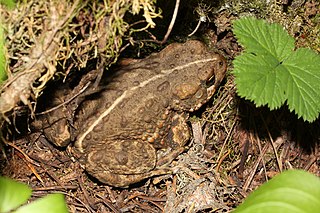
The western toad is a large toad species, between 5.6 and 13 cm long, native to western North America. A. boreas is frequently encountered during the wet season on roads, or near water at other times. It can jump a considerable distance for a toad. Breeding occurs between March and July in mountainous areas, and as early as January in lower-elevation regions. The female lays up to 17,000 eggs stuck together in strings that adhere to vegetation and other objects along water edges.
Stoliczkia khasiensis is a species of snake in the family Xenodermidae. It is endemic to Meghalaya, Northeast India. The type locality is Khasi Hills.

The Meghalaya subtropical forests is an ecoregion of Northeast India. The ecoregion covers an area of 41,700 square kilometers (16,100 sq mi), and despite its name, comprise not only the state of Meghalaya, but also parts of southern Assam, and a tiny bit of Nagaland around Dimapur. It also contains many other habitats than subtropical forests, but the montane subtropical forests found in Meghalaya is an important biome, and was once much more widespread in the region, and for these reasons chosen as the most suitable name. The scientific designation is IM0126.
Bufoides is a small genus of true toads, family Bufonidae. The genus is endemic to Northeast India, with one species known from the Garo and Khasi Hills.
Bufoides kempi is a species of true toad, family Bufonidae. This poorly known species is endemic to Meghalaya, Northeast India. It is only known with certainty from its type series collected "above Tura" at 2,500 ft (760 m) in the Garo Hills no later than 1919; there is also a possible record collected at around 2009. Its common names are Kemp's Asian tree toad, Garo Hills toad, and Garo Hills tree toad. The specific name kempi honours Stanley Wells Kemp, an English zoologist and anthropologist.

Boettger's horned toad, also known as Boettger's spadefoot toad or the pale-shouldered horned toad, is a species of toad found in southern and southeastern China and north-eastern India. A closely related but probably as yet undescribed species in found in Tibet.

Duttaphrynus himalayanus, also known as the Himalaya toad, Himalayan toad, Himalayan broad-skulled toad, and Günther's high altitude toad, is a species of toad that is widely distributed throughout the Himalayan mountains. The Yunnanese populations are sometimes considered a separate species, Duttaphrynus cyphosus.
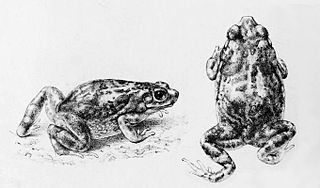
Duttaphrynus hololius, known as Günther's toad, Malabar toad, or rock toad, is an uncommon, rock-dwelling toad found in the Eastern Ghats and Deccan plateau of peninsular India.

Adenomus kandianus is a species of toad in the family Bufonidae endemic to Sri Lanka. It is a high-altitude species known only from few localities. The specific name kandianus means "from Kandy" and seems to suggest that the type material came from near the city of Kandy.

Adenomus kelaartii is a species of toad in the family Bufonidae. It is endemic to Sri Lanka, where it is found in the south-west of the island at elevations between 30 and 1,230 m. The specific name kelaartii honours Edward Frederick Kelaart, a Ceylonese-born physician and zoologist.
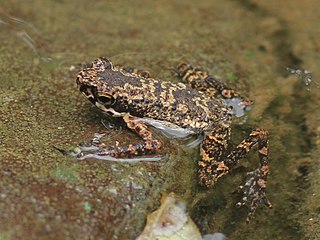
Ansonia mcgregori is a species of toad in the family Bufonidae. It is endemic to central and western Mindanao, Philippines. The specific name mcgregori honors Richard Crittenden McGregor, an Australian ornithologist who collected the holotype. Common names McGregor's toad, McGregori's river toad, and McGregor's stream toad have been coined for it.
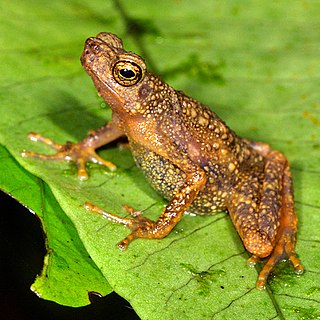
Ansonia minuta is a species of toad in the family Bufonidae, described from the forests of Sarawak in 1960. It is known by a number of common names: tiny stream toad, dwarf slender toad, and minute slender toad. It is endemic to Borneo and occurs in tropical moist lowland forests. It is threatened by habitat loss.

Atelopus ignescens, the Jambato toad or Quito stubfoot toad or Jambato harlequin frog, is a species of toad in the family Bufonidae. It is endemic to the northern Andes of Ecuador. This once abundant species was believed to be extinct until its rediscovery in 2016. The specific name ignescens means "to catch fire", presumably in reference to the orange ventral color of this species.

The pine toad is a species of toad in the family Bufonidae. It is endemic to Mexico and found on the Central Mexican Plateau.

The four-digit toad or dwarf toad is a species of toad in the family Bufonidae. It is found in Bioko, southwestern Cameroon, and southeastern Nigeria. It is the only species in the genus Didynamipus.
Werneria tandyi, also known as Tandy's torrent toad or Tandy's smalltongue toad, is a species of toad in the family Bufonidae. It is endemic to western Cameroon and known from Mount Manengouba and from the Rumpi Hills. The specific name tandyi honours Robert Mills Tandy, biologist, herpetologist, and wildlife photographer.
Leptobrachella oshanensis, also known as the Oshan metacarpal-tubercled toad or pigmy crawl frog, is a frog species in the family Megophryidae. It is endemic to southern–central China (Guizhou, Hubei, Gansu, and Sichuan provinces as well as the municipality of Chongqing). Its type locality is Mount Emei (Chinese: 峨嵋山; pinyin: Éméi Shān; Wade–Giles: O2-mei2 Shan1). The same mountain has given the species its name. It has also been reported from Thailand and Laos but these are now considered to represent Leptobrachella minimus.
The rough-skinned horned toad or Tonkin spadefoot toad is a species of frog in the family Megophryidae. It is found in southern China, northern Vietnam, and northern Laos.
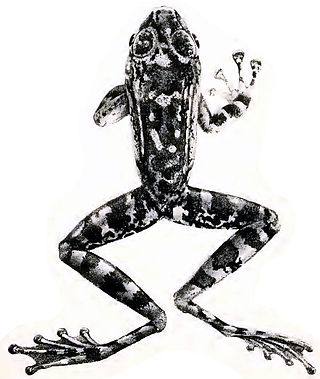
Amolops larutensis is a species of frog in the family Ranidae that is found in the Malay Peninsula from southernmost Thailand to Malaysia; records further north probably represent A. panhai.














